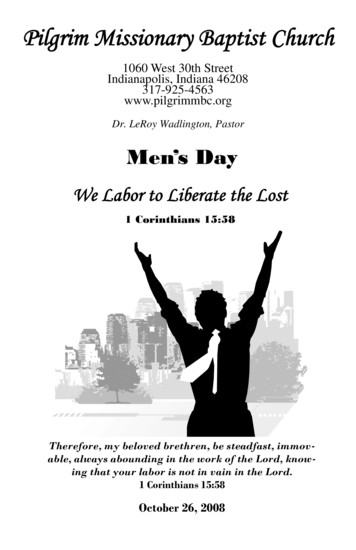History Of Computing In Medicine
History of Computing inMedicine
Beginnings 1950’s computers in bioengineering Early 1960’s––––MedlineLaboratory instrumentation computers (LINC)MUMPS developed at MGHGEMISCH (generalized medical information systemfor community health at Duke) (Stead MD) 1975 8080 processor – Altair 8800 1976 Apple ComputersHackers: Steven Levy
Beginnings Initial application: automated patientquestionnaire (Slack: ‘55) 1965– Patient centered computing– Cybermedicine Center for Clinical Computing– Dr. Slack maintained of Eliza that soliloquy, (with or without acomputer) can be a valuable tool of mental health. He wrote:"Contrary to the common notion that soliloquy is a manifestation ofmental illness, we believe that it is normal behavior---behavior thatserves to help maintain emotional equilibrium."
Eliza Eliza (MIT 1960’s) initially designed as aspoof vs. attempt to pass the Turing test– Eliza– Quack Eliza
MUMPS MGH utility multi-programming system(Octo Barnett 1966)– Thou shalt not declare variable types or file sizes.– Thou shalt not KILL, except for globals and variables.– Thou shalt not covet they neighbor's UCI (User ClassIdentification computing area).– Remember string handling, for it shall make MUMPS special.
MUMPS Now known as M– A programming language with extensive toolsfor the support of database managementsystems. MUMPS was originally used formedical records and is now widely used wheremultiple users access the same databasessimultaneously, e.g. banks, stock exchanges,travel agencies, hospitals.
MUMPS Language plus data structure Designed by MD’s and engineers– Designed for medical environment Low computing power – data entry computingFlexible string structureInverted tree structure (sparse)Multi-user environmentInterpreted– More flexible, efficiency not necessary
MUMPS code f p 2,3:2 s q 1 x "f f 3:2 q:f*f p!'q sq p#f" w:q p,? x\8 1*8– prints a table of primes, including code toformat it neatly into columns
Beginnings 1977 – Medical Informatics defined– Discipline dealing with the problems associated withinformation, its acquisition, analysis and disseminationin the health care delivery process 1978 – DEC transitions from PDP to VAX 1980 – IBM PC (MS-DOS) 1982 – medical informatics definition expanded toinclude care, education and research
Beginnings 1983 – Shortliffe “medical informatics coversmore than just applications of computers tomedicine” 1986– Macintosh developed– AAMC “medical informatics combines medical sciencewith several disciplines in the information andcomputer sciences and provides methodologies bywhich these can contribute to better patient care”
Artificial Intelligence inMedicine Clancey, Shortliffe (1984)– Medical artificial intelligence is primarily concernedwith the construction of AI programs that performdiagnosis and make therapy recommendations. Unlikemedical applications based on other programmingmethods, such as purely statistical and probabilisticmethods, medical AI programs are based on symbolicmodels of disease entities and their relationship topatient factors and clinical manifestations
Early AIM Internist/QMR– Designed at University of Pittsburgh Mycin, Oncocin– Designed at Stanford by Shortliffe’s group
AIM Internist– Designed to reproduce the behavior of adiagnostician
Maturation of medical computing
History 1985-1995 Emergence of HIS– Financial information ahead of clinicalinformation Introduction of PC’s into offices (initiallyfor clerical use) PC’s on units for data output– Statlan (DOS based – non Y2Kcompliant) Clinical information systems (CIS)
History 1995-present Internet medicineWiring of health systemsPC’s in MD’s officesPC’s for order entry, web access etc.Acquisition of large data bases
Now AI in medicine (nascent) Computers in the business of medicine– Electronic billing (maturing) Information flow– Lab, radiology (maturing)– Medical Record (nascent) Patient care– Intelligent monitoring (nascent)
Now Consumer awareness– Information availability (growing rapidly)– Quackery!!! (growing rapidlier) Efficiency gains– Decreased personnel (nascent)– Best/least costly practices (nascent)– Information flow (nascent)
Current resources AMIA curriculum 2001Health information resources on the webIT Medical LiteratureNewsgroups/chat rooms/supportHealth news
Future Compare American (vs. Japanese) industryin the late 1980’s Barriers
History 1995-present Internet medicine Wiring of health systems PC’s in MD’s offices PC’s for order entry, web access etc. Acquisition of large data bases. Now AI in medicine (nascent) . History of Computing in Medicine Author: C. William Hanson III MD
Cloud Computing J.B.I.E.T Page 5 Computing Paradigm Distinctions . The high-technology community has argued for many years about the precise definitions of centralized computing, parallel computing, distributed computing, and cloud computing. In general, distributed computing is the opposite of centralized computing.
distributed. Some authors consider cloud computing to be a form of utility computing or service computing. Ubiquitous computing refers to computing with pervasive devices at any place and time using wired or wireless communication. Internet computing is even broader and covers all computing paradigms over the Internet.
15th Cent. History of Medicine see History, 15th Century 15th Cent. Medicine see History, 15th Century 15th Century History see History, 15th Century 16-alpha-Hydroxy-Estradiolsee Estriol 16alpha,17beta-Estriolsee Estriol 16beta-Hydroxy-Estradiolsee Estriol 16th Cent. History (Medicine) see History, 16th Century 16th Cent. History of Medicine .
equine medicine b. Food animal or large animal medicine c. Exotic animal medicine d. Marine animal medicine (mammal and fish) e. Poultry medicine f. Wildlife medicine and aquaculture medicine 2. Discuss with your counselor the roles a veterinarian plays in the following: a. Public health medicine and zoonotic disease surveillance and control b .
DEPARTMENT DIVISION NAME Family Medicine Palliative Medicine Algu,Kavita Palliative Medicine Arvanitis,Jennifer Palliative Medicine Berman,Hershl (Hal) Palliative Medicine Buchman,Stephen (Sandy) Palliative Medicine Cellarius,Victor Palliative Medicine Goldman,Russell Palliative Medicine Hashemi,Narges Palliative Medicine Howe,Marnie
Chapter 10 Cloud Computing: A Paradigm Shift 118 119 The Business Values of Cloud Computing Cost savings was the initial selling point of cloud computing. Cloud computing changes the way organisations think about IT costs. Advocates of cloud computing suggest that cloud computing will result in cost savings through
Family Medicine Hougas, III, James Ehrling Bergquist Hospital Offutt AFB NE Family Medicine Howard, Sarah Clarkson Family Medicine Residency Omaha NE Family Medicine McNab, Molly Family Medicine Spokane Spokane WA Family Medicine Monson‐Walker, Jeanette Family Medicine Residency of Idaho Boise ID
Annual Men’s Day Sunday, October 26, 2008 Order of Service Devotion Men’s Day Praise Team Responsive Reading Psalm 1 Congregational Singing This Little Light of Mine Selection Men’s Day Choir Altar Prayer Dance Selection Creations of God Announcements Bro. Robert Shields Pastoral Observations Message Rev. Jeffery A. Lang, Senior Pastor Southside Church & International Ministries Jackson .























